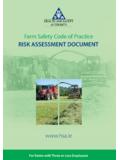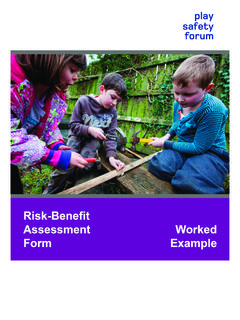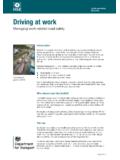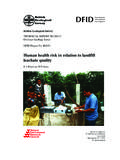Transcription of Introduction to Risk Assessment - European Commission
1 1 Risk AssessmentIntroduction to Risk AssessmentIntroduction to Risk AssessmentChildren's Health and the EnvironmentChildren's Health and the EnvironmentCHEST Training Package for the Health SectorCHEST Training Package for the Health SectorTRAINING FOR THE HEALTH SECTORTRAINING FOR THE HEALTH SECTOR<<NOTE TO USER: Please add details of the date, time, place andsponsorship of the meeting for which you are using this presentation.>>2 Risk AssessmentDefinition of risk assessmentRisk = Undesirable consequence of aparticular activity in relation to the likelihood that it may occurRisk Assessment is an estimate of the likelihood of adverse effects that may result from exposure to certain health hazards, esp. pollutants in the Webster's New Millennium Dictionary of English, Preview Edition (v ), 2004 LexicoPublishing Group, LLC ( + Assessment &r=67)In 1983, the National Academy of Sciences (NAS) published standard terminology and concepts for risk management decisions follow the identification and quantification of risk which are determined by risk assessments.
2 During the regulatory process, risk managers may request that additional risk assessments be conducted to justify the risk management decisions. As indicatedin the figure above, the risk Assessment and risk management processes are intimately section will describe only the risk Assessment process. Risk assessments may be conducted for individual chemicals or for complex mixtures of chemicals. In cases of complex mixtures, such as hazardous waste sites, the process of risk Assessment itself becomes quitecomplex. This complexity results from:- simultaneous exposure to many substances with the potential for numerous chemical and biological interactions- exposures by multiple media and pathways( , via water, air, and soil)- exposure to a wide array of organisms with differing susceptibilities( , infants, adults, humans, animals, environmental organisms)Question: The definition of risk is:O the capacity of a substance to cause an adverse effect in a specific organ or organ system O the probability that a hazard will occur under specific exposure conditions O the weighing of policy alternatives and selection of the most appropriate regulatory actions Answer.
3 Risk Assessment results in a statistically derived probability that an adverse effect will occur at a defined exposure AssessmentHazardHazardCapabilityCapabili tyof of substancesubstancetotocausecauseananadve rseadverseeffecteffectRiskRiskProbabilit y that Probability that the hazard the hazard will occur will occur under specific exposure conditionsunder specific exposure conditionsRisk Risk AssessmentAssessmentThe The process by which process by which hazards, hazards, exposureexposure, and risk are , and risk are determineddeterminedRisk Risk ManagementManagementThe The process process of of weighing policy weighing policy altenatives altenatives and and selecting selecting the most the most appropriate regulatory action based appropriate regulatory action based on on the the results results of risk of risk Assessment Assessment and and socialsocial, , economiceconomic, and , and policitical policitical concernsconcernsThe following terms are routinely used in risk assessments:HazardRiskRisk assessmentRisk management 4 Risk AssessmentA risk is the chance that an adverse A risk is the chance that an adverse event will happen, multiplied by event will happen, multiplied by the extent of the effectthe extent of the effectR = F x E R = F x E Risk is Frequency x EffectRisk is Frequency x EffectThis is a common way of defining AssessmentExpression of risks NonNon--thresholdthresholdsubstancessubs tancesprobability of additional cases per unit of timein a specified population cancer risk Threshold substancesThreshold substancesExposure/no-effect level ratio for a specified population or ecosystem.
4 Cancer risk means that there is one additional case of cancer during a lifetime in a population of a million human carcinogenic risks associated with chemical exposureare expressed in terms of an increased probability of developing cancer during a person's lifetime. For example, a 10-6increased cancer riskrepresents an increased lifetime risk of 1 in 1,000,000 for developing cancer. For carcinogenicity, the probability of an individual developing cancer over a lifetime is estimated by multiplying the cancer slopefactor (mg/kg/day)for the substance by the chronic(70-year average)daily intake (mg/kg-day).Threshold substancesThere is a need for exposure above a certain level before effects can be observed. For each compound a exposure/no-effect levele ration should AssessmentFour basic steps in the risk Assessment process as defined are:Hazard identification: characterization of innate adverse toxic effects of agentsDose-repsonse Assessment ; characterisation of the realtion between doses and incidences of adverse effects in epxosed populationsExposure Assessment ; measurement or estimation of the intensity, frequency, and duration of human exposures to agentsRisk characterisation.
5 Estiamtion of the incidence of health effects under the various conditions of human exposure7 Risk AssessmentRisk Assessment Risk Assessment 4 phases4 phases Hazard identificationHazard identification requires insight requires insight and understanding of the system in questionand understanding of the system in question DoseDose--Response assessmentResponse Assessment costs time costs time and money for hard science and money for hard science positive positive findings require actionfindings require action Exposure assessmentExposure Assessment can be very can be very expensive and, for human exposure, expensive and, for human exposure, complexcomplex Risk characterisation Risk characterisation --depends totally on depends totally on the 1the 1ststthree stepsthree stepsHazard and risk are not the same thing. If you cross the road you could be hit by a bus. That is a potential hazard. The probability of being hit by a bus whenever you cross the road is related to the the risk.
6 There are many factors that would need to be known in estimating that risk. What is the frequency of buses, is it day or night, dry or wet, etc etc. To discover those facts would require there are a series of steps in a risk Assessment that are required. Hazard identification is clearly crucial. For those hazards identified there needs to be an Assessment or characterisation. This requires hard science, which costs money. If there is an adverse outcome from any investigations then there is a need for action, one of which might be to ban the AssessmentThe hazard identification process determines whether exposure to a chemical can increase the incidence of a particular adverse health effect and determines the likelihood of occurrence in IdentificationHazard IdentificationHazard identification: in this initial step, the potential for a xenobiotic to induce any type of toxic hazard is is gathered and analyzed in a weight-of-evidence approach. The types of data usually consist of:- human epidemiology data- animal bioassay data- supporting dataBased on these results, one or more toxic hazards may be identified(such as cancer, birth defects, chronic toxicity, neurotoxicity).
7 The primary hazard of concern is one in which there is a serious health consequence(such as cancer) that can occur at lower dosages than other serious toxic effects. The primary hazard of concern will be chosen for the dose-response : In the risk Assessment process, the hazard identification step performs which of the following functions?- characterizes the relation between doses and incidences of adverse effects inexposed populations - measures or estimates the intensity, frequency, and duration of human exposures to agents - characterizes the innate adverse toxic effects of agents Answer:Hazard identification is the first step in the risk Assessment Assessment Human epidemiology data Animal bioassay data Supporting dataHazard Identification dataHazard Identification dataHuman epidemiology data are the most desirable and are given highest priority since they avoid the concern for species differences in the toxic response. Unfortunately, reliable epidemiology studies are rarely available.
8 Even when epidemiology studies have been conducted, they usually have incomplete and unreliable exposure histories. For this reason, it is rare that risk assessors can construct a reliable dose-response relationship for toxic effects based onepidemiology studies. More often, the human studies can only provide qualitative evidence that a causal relationship practice, animal bioassay data are generally the primary data used in risk assessments. Animalstudies are well-controlled experiments with known exposures and employ detailed, careful clinical, and pathological examinations. The use of laboratory animals to determine potential toxic effects in humansis a necessary and accepted procedure. It is a recognized fact that effects in laboratory animals are usually similar to those observed in humans at comparable dose levels. Exceptions are primarily attributable to differences in the pharmacokinetics and metabolism of the data derived from cell and biochemical studies may help the risk assessor make meaningful predictions as to likely human response.
9 For example, often a chemical is tested with both human and animal cells to study its ability to produce cytotoxicity, mutations, and DNA damage. The cell studies canhelp identify the mechanism by which a substance has produced an effect in the animal bioassay. In addition, species differences may be revealed and taken into : What data are most desirable to identify the primary hazard in the hazard identification step?O animal bioassay data O supporting data from cell and biochemical studies O human epidemiology dataAnswer: Human data are the most desirable to identify the primary hazard in the hazard identification step and are given highest priority since there may be species differences in toxic response. Unfortunately, human epidemiology data are not often Assessment Structure-activity relationship (SAR)Prediction of Hazard Prediction of Hazard A chemical's toxicity may be predicted based on its similarity in structure to that of chemical for which the toxicity is known.
10 This is known as a structure-activity relationship (SAR). The SAR has only limited value in risk Assessment due to exceptions to the predicted : The structure-activity relationship (SAR) has value in risk assessments in that it:O can often be used to predict possible toxicity O is used to design cell studies of the chemical's metabolism O can identify damage to DNA by actual testing of its chemical activityand biochemical structure Answer: The structure-activity relationship (SAR) has value in risk assessments in that it can often be used to predict possible toxicity. In the absence of actual test data for a chemical, its potential toxicity can often be predicted by comparing its chemical structure to structures of chemicals whose toxicity has been AssessmentThe dose-response Assessment describes the relationship between the magnitude of exposure and the appearance and duration of adverse AssessmentResponse AssessmentThe dose-response Assessment step quantitates the hazards which were identified in the hazard evaluation phase.

















